 If you always do what you’ve always done, you’ll always get what you’ve always got – Henry Ford
If you always do what you’ve always done, you’ll always get what you’ve always got – Henry Ford
Convention says that if musicians practise daily, no matter how long or short the window, the cumulative effect will pay off over time. For many however, the reality is that practice lasts minutes rather than hours and is not a daily ritual. Equally important therefore is quality over quantity.
Investing time is one thing, but practising productively is another. Let’s be brutally honest. Irrespective of duration and regularity, could our practice regime benefit from better structure and, if so, where do we begin?
Don’t practise until you get it right, practise until you can’t get it wrong
Our recommended practice content is set out below. No doubt you already include much of this in your routine, but there may be a few ideas you haven’t yet contemplated. Before we run through the list, let’s review the two overarching criteria we consider essential for effective practising.
 Firstly, the quest for control in all you do. Identify where your weaknesses and fears lie, face them and fix them. Don’t gloss over the cracks. If for example your playing is a little untidy, or your timekeeping is off, address this and seek to remedy it. Being in control means you decide when to add texture or introduce elasticity of timing. Begin the corrective process by slowing things down and being more meticulous.
Firstly, the quest for control in all you do. Identify where your weaknesses and fears lie, face them and fix them. Don’t gloss over the cracks. If for example your playing is a little untidy, or your timekeeping is off, address this and seek to remedy it. Being in control means you decide when to add texture or introduce elasticity of timing. Begin the corrective process by slowing things down and being more meticulous.
Secondly, whether you’re playing a scale, an exercise or a complete tune, take a moment to close your eyes, shut out the notation and digital tuners, and really listen. This builds self reliance and mindfulness as you engage exclusively with your sound and your instrument.
If your aim is to play and improvise more effectively, practise is your enabler and good discipline is how you will achieve your goals. Enjoy the journey and know that while there will be times when progress seems abstract, the eureka moments will bring ample compensation. Above all, take pleasure in growing musically.
WARM UPS
As musical athletes there are three things we need to warm up before we embark on our practical regime: lips, lungs and Luger. In other words embouchure, breath control and instrument. This is just like stretching before a physical work out or a long run.

Embouchure
Whatever the embouchure you use, loosen up your ‘mask’ and jaw. At the Harp Surgery we enunciate a phrase such as ‘I like to play harmonica’ while pulling different faces:
• Fish face – purse your best selfie lips
• Turtle face – cover your teeth with your lips
• Cheshire cat – grin from ear to ear
• Hot potato – drop your jaw and form a large O with your lips
Now exhale and make your lips flap like a horse sneezing. Finally, gently slide your jaw side to side to loosen up. This is light hearted, but there’s plenty of serious stuff to follow and hopefully you are now in the zone. These exercises also makes a great ice-breaker for anyone leading group workshops.
Breath control
Breath control is where everything starts and ends. Ignore it at your peril. Fundamentally it’s about managing the transfer of an air column to and from your lungs, and in this sense the harmonica is incidental. If you take a moment to thoroughly review your breathing, it will have a positive impact on your tone and the way you play.
Principally we need to connect with our diaphragm and learn to control our inhaled and exhaled breath from deep down in the abdomen. We also need to open our vocal tract and chest to add depth to our sound. And let’s not ignore the role our nasal cavity plays as a pressure valve.
Unlike other wind instruments we don’t have the benefit of a long tube to create resonance; we must produce this from within. As harmonica players, this is probably why we enjoy greater natural ambience on our draw notes than our blow notes.

The terms inhale and exhale are used advisedly by the way. If we literally blow and suck from our mouth and cheeks, we are playing too vigorously. This approach lacks depth and our tone will suffer. Inhaling and exhaling is also about measured air movement rather than force. Too much force will stress the harmonica’s reeds causing them to jam or sound off-tone.
Subconsciously, placing anything in our lips or mouth signals mealtime and our tongue enters the equation. If you manipulate your tongue at this stage however, you can activate the bending process and your notes will sound flat or choked. Keep your tongue resting in a neutral position as you build breathing exercises in your routine. This will promote a full and balanced sound. You can investigate our system for breathing warm ups more fully here.
Harmonica
Harmonicas respond well to warmth and humidity. Your harmonica will warm up once you start playing scales and exercises of course, but be mindful about playing heavily on a cold harmonica as this may damage reeds. In colder settings spend a moment warming up the harmonica in your hands, then start playing gently. Follow this up with light chugging and exercises to bring your embouchure, diaphragm and harmonica together.
Breathing Exercise
Visit our Warm Ups and Workout to get your routine underway. Rhythm playing or chugging, often called vamping, are also an important part of developing breath control. Seek out tunes that require this approach.
 SCALES
SCALES
A scale is a prescribed sequence of notes played in an ascending or descending order. The word scale stems from the Latin scala meaning a ladder or flight of stairs, and in English we use the word escalator for a moving staircase. Playing scales is how we establish our musical vocabulary. They provide the musical words we need to build musical phrases, and our first goal is to enunciate them clearly. This means playing accurate single notes with good tone.
Good tone takes us back to breath control, which we’ve covered above. Playing accurately starts with decent embouchure, but it also requires ‘ear muscle’. Can we identify whether the sound we’re making is clean or distorted? Listen well, identify your target notes, adjust your aim accordingly, and eliminate any intrusive notes. Once again, don’t gloss over the cracks. If you have difficulty identifying the sound of clean notes, invest in a digital tuner or find Bend It Better™ online, and this will provide a helpful visual reference.
With accuracy and tone in check, we need to develop transferable skills by working along our scale in a linear fashion, smoothly and fluently. This action requires lateral and diagonal movement, slide skills and, in time, reed bending ability.
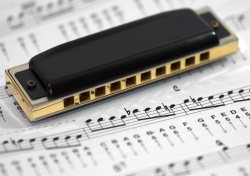 Plodding up and down a scale in a linear form is necessary at the outset, but in time we need to introduce challenges that will develop fluency and phrasing. This is where playing in couplets, triplets and further combinations is beneficial, as well as stepped scales. Accenting specific notes within our patterns will promote good use of rhythm. Using a specific note as a base to leap from and return to will improve accuracy of note placement. Doing all this with two hands on our harmonica will develop the muscle memory that will eventually deliver our target notes automatically.
Plodding up and down a scale in a linear form is necessary at the outset, but in time we need to introduce challenges that will develop fluency and phrasing. This is where playing in couplets, triplets and further combinations is beneficial, as well as stepped scales. Accenting specific notes within our patterns will promote good use of rhythm. Using a specific note as a base to leap from and return to will improve accuracy of note placement. Doing all this with two hands on our harmonica will develop the muscle memory that will eventually deliver our target notes automatically.
Setting a metronome to a manageable tempo, then increasing speed will help to determine where our accuracy threshold lies. With practice we can increase tempo without losing control. Subdividing, or doubling up the speed of our note playing is a reliable route to playing fast sequences if this is your goal.
And remember, there are many different types of scale. Diatonic, modal, chromatic, major, minor, pentatonic, blues, jazz and bebop are just a few. But think of each one as a musical dialect. Identifying the scale intrinsic to a particular song will unlock its DNA and open up the best avenue for improvisation. As an example, a common trap for harmonica players who first learn blues is controlling the urge to visit 5D (the Dominant Seventh) when playing pieces set over the Major Pentatonic Scale or Major Seventh Chord.
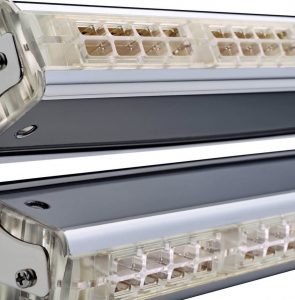
ARPEGGIOS
Modern music is principally based on chord progressions. If scales are our vocabulary, chords patterns are our grammar. Unlike other wind instruments, we do have the privilege of a limited number of chords on the diatonic harmonica. Where these options run out however, we become a solo wind instrument like any other.
As a soloist therefore, we must learn to locate the salient notes of chords in a deconstructed or broken form, otherwise known as arpeggio. If we were to check out an orchestral chord harmonica, we’d see exactly this; block upon block of arpeggios. At which point we start referring to notes by their scale degree numbers, rather than their note names. Effectively we are moving into a world of sound shapes and formulae. A piano keyboard is an extremely helpful reference tool in this respect.
 A major chord, for example, comprises the first, third and fifth degrees of the major scale, with the first degree being the root note (or tonic). For the C Major chord, C, E and G become scale degrees I, III and V. If we know where to locate these on our harmonica, we have a stable road map from which to work. We can then add connecting notes from the major scale (our musical vocabulary) and create phrases (musical sentences).
A major chord, for example, comprises the first, third and fifth degrees of the major scale, with the first degree being the root note (or tonic). For the C Major chord, C, E and G become scale degrees I, III and V. If we know where to locate these on our harmonica, we have a stable road map from which to work. We can then add connecting notes from the major scale (our musical vocabulary) and create phrases (musical sentences).
In addition to musical eloquence, navigating arpeggios also brings dexterity as we learn to place notes the length of the harmonica. Try the opening to ABBA’s Super Trouper, The Beach Boys Wouldn’t It Be Nice or the head from Guns and Roses Sweet Child of Mine. Alternatively learn the whole of Beethoven’s Moonlight Sonata, or Bach’s Jesu Joy. Arpeggios provide a foundation for improvisation over chord progressions and a library of stock phrases you can roll out that will always sound musical.

TECHNIQUE
This is where we reach a fork in the road. We can work on technique in isolation, perhaps using prescribed exercises, but we will eventually need an outlet for the technique itself. Alternatively we can work on technique in the context of repertoire, only to find we need to isolate the technique for a spell of ‘woodshedding’. Whichever route you choose, remember that control is the goal.
In isolation
This often has to do with training muscle groups and coordination for things like bends, overbends, flutters, intervals, vibrato and trills. It can also help with the early stages of switching embouchures from lip pursing to tongue blocking, or vice versa. If these techniques remain in isolation however, they become meaningless; we’re simply body-building.
In context
Learning songs to challenge our skill set helps to develop musical athleticism and makes technique development meaningful. Examples might be high end playing with tongue vibrato, specific overbend tones, new positional and modal playing, or breaking out of a rigid I IV V blues chord progression into a jazzy ii V I. However, there will be times when we need to press the pause button and practice a specific technique in isolation, before reinstalling it and turning the engine.
 REPERTOIRE
REPERTOIRE
This is why we love to play music. Whether for personal satisfaction or performance, songs are king. When learning repertoire, try to transcribe songs into harmonica tab or standard notation for yourself rather than putting out an APB on social media.
The same goes for song keys. Harmonica teachers’ inboxes and social media forums are full of people asking what key a song is played in. As the old proverb goes, give a man a fish and you feed him for a day; teach a man to fish and you feed him for life. At Harp Surgery’s workshops we often open with a random piece of music and the question what key? This is usually followed by the question what harmonica position?
A good way to start the process of identifying song keys is to sing Happy Birthday but leave out the last note. In doing so you feel the gravitational pull that reveals its role as the tonic or key note of the song. Next, internalise the note by humming it for a moment, then run through the C major scale 4B 4D 5B 5D 6B 6D 7D 7B on your C harmonica and see which note it matches. Et voila, you’ve cracked the enigma code for yourself. If the note you’re humming falls between two notes on your harmonica, it’s a flattened or sharpened key.
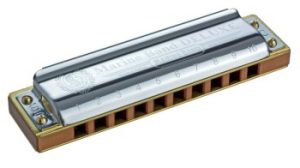 Some others points to ponder are the song’s chord progression. Remember this is the grammar you need in order to sound musically competent. Listen to the dynamics and whether to play legato or staccato. Ask yourself what other techniques may help, such as intervals, double stops, glissandos or trills.
Some others points to ponder are the song’s chord progression. Remember this is the grammar you need in order to sound musically competent. Listen to the dynamics and whether to play legato or staccato. Ask yourself what other techniques may help, such as intervals, double stops, glissandos or trills.
Ask yourself too, what musical concept the piece embodies? What, for instance, is the musical DNA of Summertime, compared with Georgia on My Mind, Dirty Old Town, or Auld Lang Syne? And what new ideas does each piece inspire? Once you have all this squared away, as we recommended at the beginning of this page, learn to play with your eyes closed and lose yourself in the music.
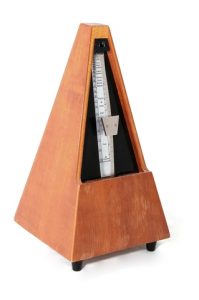 TIMEKEEPING
TIMEKEEPING
To misquote Gershwin, ‘I got rhythm, I got music, who could ask for anything more?‘ The short answer is any musician who doesn’t have a metronome. How many times has a band started a piece, only to discover the singer can’t squeeze in the words? How many times do we inadvertently slow down, speed up or lose the beat? Correct tempo and accurate timekeeping is the glue that holds music and musicians together.
Once you’ve sketched out a new piece of repertoire, play it to a metronome and notice how things instantly sound more musical. Notice also how this can expose the weaker points in your delivery. There are plenty of free smart phone and online apps that will do the job. Otherwise order a mechanical metronome online and give it pride of place in your practice space.
UNSTRUCTURED PRACTISE
 This is a form of practice we all do naturally. We wake up in a good mood, or hear a familiar song on the radio and we start to play. Exploring the harmonica and working stuff out for ourselves can be immensely productive. As an alternative, why not challenge yourself with something apparently unattainable, like modulating the major scale on a C harp through all twelve keys?
This is a form of practice we all do naturally. We wake up in a good mood, or hear a familiar song on the radio and we start to play. Exploring the harmonica and working stuff out for ourselves can be immensely productive. As an alternative, why not challenge yourself with something apparently unattainable, like modulating the major scale on a C harp through all twelve keys?
You’ll be amazed at what you pick up and how swiftly your nightmares are exposed as mind forged manacles. In short, just spend time with your harp. Do whatever comes into your head. Celebrate the moment by exploring your instrument and your imagination. It’s a great way to decompress.
IMPROVISATION
Once you’ve broken the back of learning a new piece, there comes a moment when you instinctively add your own embellishment. This is the start of improvisation. You’re comfortable with the song and its structure, and you’ve selected the best harmonica position for the job. You’re now effectively under the skin of the song.
Christelle Berthon recently described herself not as a musician, but as a musical actress. Once the framework is learned, she’s ready to pour out her emotions and lose herself as she performs. The concept of musical formality fades as she transcends from musician to artist. Notes become colours and musical expression is a collage of sound.
 For many of us however, the call to solo or improvise is like being handed a blank page. Where do we start? The first step is to mentally turn the page. Instead of reeling from an apparent lack of direction, we should embrace the invitation to say something musical. Suddenly a page with nothing on becomes a page with anything on. Whereupon we can draw ideas from the song’s groove, its underlying scale form, its melody, its riff or head, its chord progression and arpeggios, its musical style, the other musicians involved or an impulse all of our own.
For many of us however, the call to solo or improvise is like being handed a blank page. Where do we start? The first step is to mentally turn the page. Instead of reeling from an apparent lack of direction, we should embrace the invitation to say something musical. Suddenly a page with nothing on becomes a page with anything on. Whereupon we can draw ideas from the song’s groove, its underlying scale form, its melody, its riff or head, its chord progression and arpeggios, its musical style, the other musicians involved or an impulse all of our own.
Whatever you do, the best advice comes from the top, in this case Charlie Musselwhite. ‘You need to play from the heart. Some of them [the fast players] could sign up to notes anonymous! They have a huge vocabulary, but nothing much to say.’ In the meantime, albeit self-contradictory, you can practise improvisation. Get your scales together, build a library of backing tracks and an arsenal of prize licks from the masters and keep at it. You’ll find plenty of backing tracks on YouTube, iTunes and other music platforms.
PERFORMANCE
This is the acid test for all your practising. When your audience is seated and the song is counted in, are you up to the job? Can you close your eyes and play unaided? Can you anticipate what comes next? And are you contributing to the song or just using it as a platform for ego?
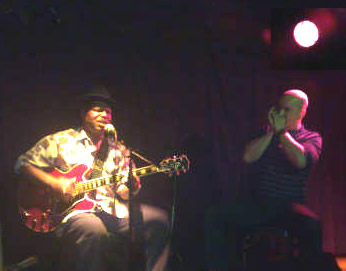 When you practise, record yourself to identify any weaknesses in your delivery. Jam with friends, invite their feedback and act on it. Ultimately, take the plunge and see if what you’ve learned stacks up on stage. If not, park it and default to safe mode. Don’t use an audience to practise on, but perhaps try a spell of busking to really get the hang of things.
When you practise, record yourself to identify any weaknesses in your delivery. Jam with friends, invite their feedback and act on it. Ultimately, take the plunge and see if what you’ve learned stacks up on stage. If not, park it and default to safe mode. Don’t use an audience to practise on, but perhaps try a spell of busking to really get the hang of things.
REFLECTIVE PRACTICE
If you really want to improve, embrace reflective practise. As you work, be self-analytical and honest with yourself. Identify your mistakes, weaknesses and sticking points. Get them on the workbench and overhaul them. Don’t accommodate cheap imitation or approximation. Strive to change bad habits and recalibrate your default positions. Best of all, record or film yourself and listen back. You’ll find most of the answers are right there in front of you.
MAINTENANCE
Now that you’ve done all the hard work, refresh your repertoire to keep it in check. Revisit key skills too, as they may well take on added relevance and scope.
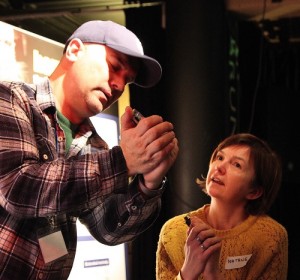 TAKES LESSONS
TAKES LESSONS
There are plenty of very good harmonica music courses online and it’s easier than ever to make your own way musically. A concern we’re hearing more and more however, is that not all online courses offer personal feedback and subscribers can begin to feel isolated. Our top tip is to book in for a lesson with a reputable harmonica teacher. You can do this and still keep your online course on the go, but ask if you can pay for a single lesson first to see if you’re happy with everything that’s on offer. At which point I would of course say the Harp Surgery is at your disposal. You can find further details right here.
FINISH THE JOB
Once you’ve rejuvenated your practice routine, there’s one last point we should highlight, and that’s the ‘kid in a sweet shop’ syndrome. Some students attempt to learn as much as possible all at once. Enthusiasm is a great thing, but there is a real risk of leaving a trail of unfinished business and adopting an approach that is counter productive. Taken to the extreme, we’ve seen students become so overawed by the magnitude of learning music that they’ve given up, junked their harmonica and walked away. Just remember, Rome wasn’t built in a day.
 The inescapable fact is that music learning is a ride that never ends, unless you decide to jump off. You cannot possibly absorb and master every aspect overnight. If you’re looking for some kind of timeframe, the blues greats of Chicago considered five years to be the minimum period of apprenticeship for any blues harmonica aspirant. Associates who have switched embouchure from lip pursing to tongue blocking say it took them six months of dedicated input.
The inescapable fact is that music learning is a ride that never ends, unless you decide to jump off. You cannot possibly absorb and master every aspect overnight. If you’re looking for some kind of timeframe, the blues greats of Chicago considered five years to be the minimum period of apprenticeship for any blues harmonica aspirant. Associates who have switched embouchure from lip pursing to tongue blocking say it took them six months of dedicated input.
Keep a sense of perspective. Think of music learning as being an author, martial artist or painter. Allow yourself to develop. Build strong foundations, work through the levels of study patiently, and at each point finish the job. As Joe Filisko would say, there’s no point juggling three balls if you can’t juggle two.
DIARY AND WORK PLAN
Which brings us to our final top tip. Keep a diary of your goals and prioritise them. Log your progress and achievements too. Run through the points above and draw up a scheme of work, allocating a specified amount of time to each category. This is your new routine. Thirty minutes a day for one month will accumulate between ten and fifteen hours of study time. Be thorough. Be disciplined. And remember that the main difference between you and those with talent is practice.
